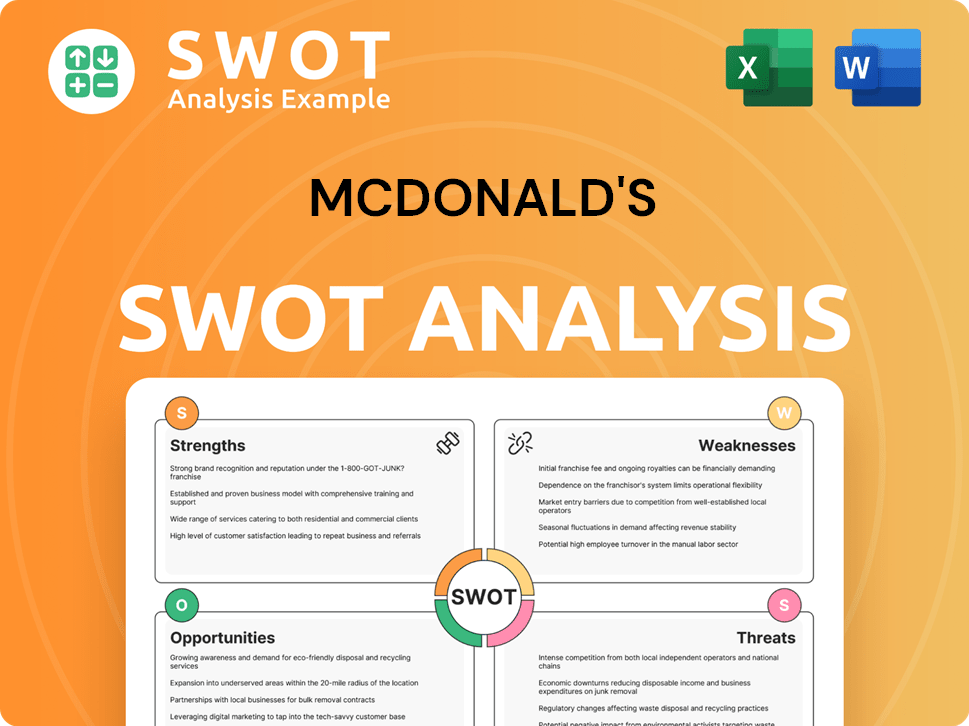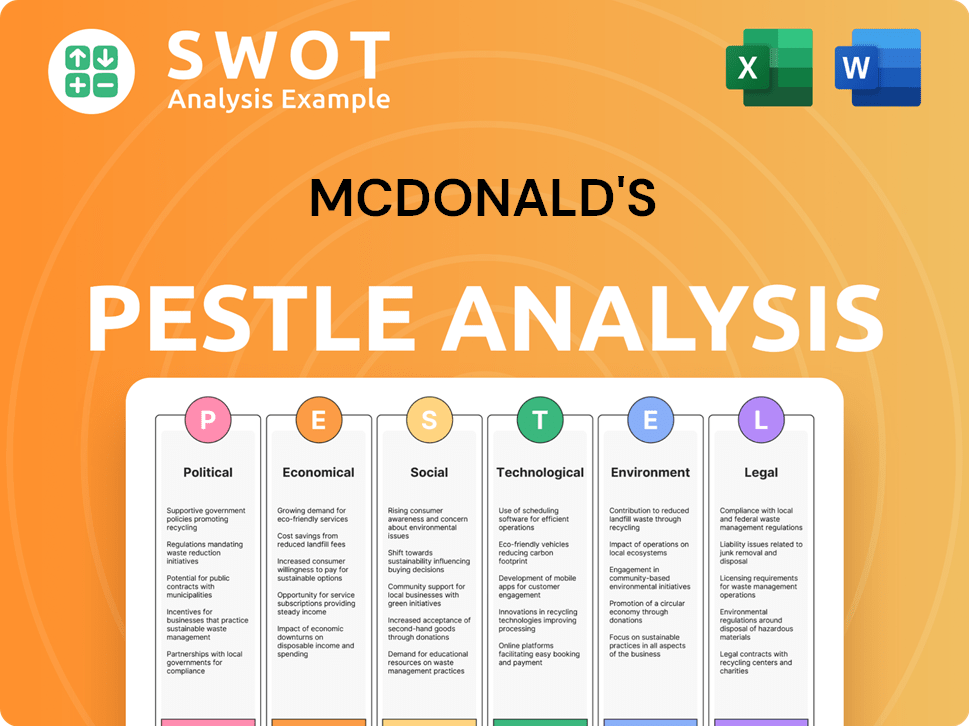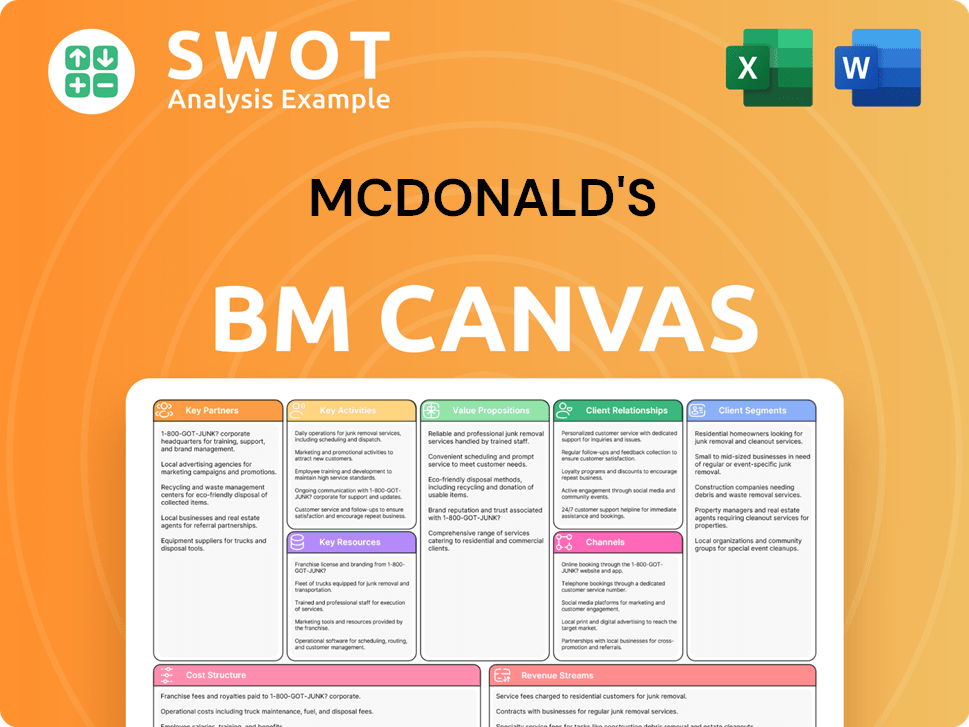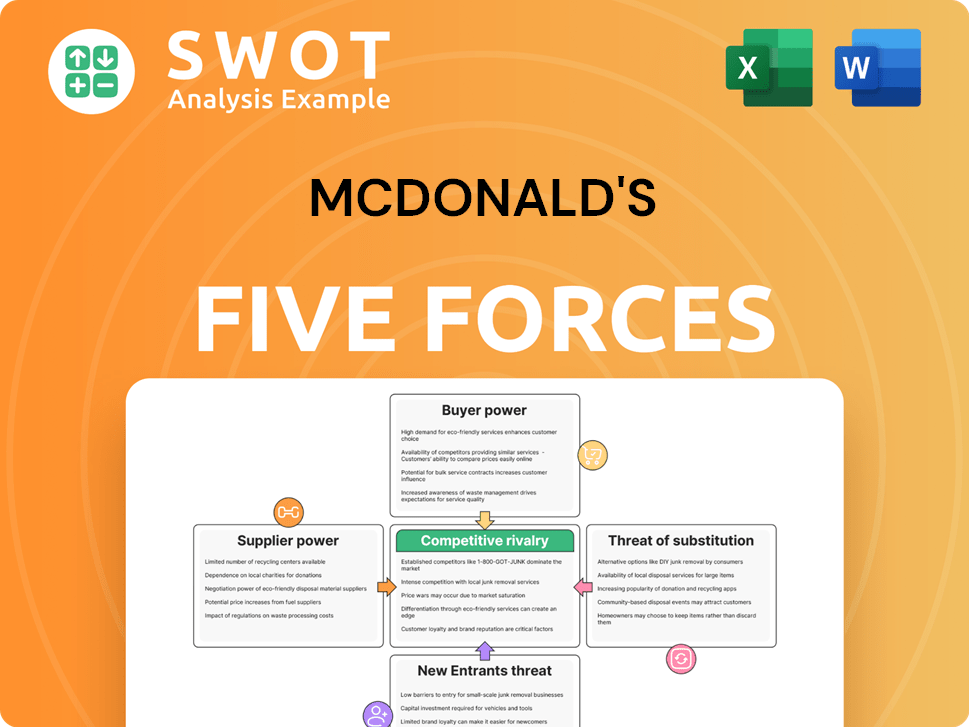McDonald's Bundle
How Does McDonald's Stay on Top?
From its humble beginnings as a California barbecue joint, McDonald's has become a global fast-food empire. The iconic "I'm Lovin' It" campaign is just one example of how McDonald's has masterfully crafted its brand. But what's the secret sauce behind their continued success? This article explores the McDonald's SWOT Analysis and the innovative sales and marketing strategies that keep customers coming back for more.

Understanding McDonald's sales strategy and marketing strategy is crucial for anyone looking to learn from a global leader. We'll examine their marketing plan, including their digital marketing initiatives and promotional activities, to see how they maintain their competitive advantage. Discover how McDonald's targets its market, implements its brand positioning strategy, and overcomes sales and marketing challenges in the fast-paced food industry, focusing on its sales growth strategies and global marketing approach.
How Does McDonald's Reach Its Customers?
The sales channels of the company are a critical component of its overall business strategy, driving revenue and customer engagement. The company's approach to sales is multifaceted, leveraging both traditional and digital channels to reach a broad consumer base. Understanding these channels is essential for analyzing the company's market presence and its ability to adapt to changing consumer behaviors.
McDonald's sales strategy relies heavily on its franchise model, which allows for rapid expansion and localized operations. This model supports the company's global reach while ensuring brand consistency. Furthermore, the company has strategically integrated digital platforms and delivery services to enhance customer convenience and accessibility.
The company's sales strategy is designed to meet the evolving needs of its customers. By focusing on both physical locations and digital platforms, the company aims to provide a seamless and convenient experience. This approach has enabled the company to maintain its competitive advantage in the fast-food industry.
The franchise model is the cornerstone of the company's sales strategy. Approximately 95% of its global restaurants are owned and operated by franchisees as of early 2024. This model facilitates rapid expansion and localized management, ensuring brand consistency across different markets. Franchisees contribute significantly to the company's revenue and market penetration.
Physical retail locations remain a crucial sales channel, offering dine-in, drive-thru, and increasingly, McDelivery services. The drive-thru channel has experienced substantial growth, particularly after the pandemic. These locations provide direct customer interaction and support the company's brand presence.
The company has significantly invested in digital platforms and omnichannel integration. This includes its mobile app for ordering and payment, which enhances convenience and personalization. The company has also partnered with third-party delivery services like Uber Eats, DoorDash, and Grubhub to expand its reach.
Partnerships with delivery platforms have become essential for expanding reach and catering to changing consumer preferences. These partnerships have been a key driver of growth, particularly in urban areas. These services provide convenience and accessibility, further enhancing the customer experience.
Digital sales have become a significant portion of the company's total sales, especially in key markets. In 2023, digital sales exceeded $20 billion across its top six markets. The company is continuously refining its omnichannel strategy to provide a seamless customer experience across all touchpoints.
- The company's digital initiatives include mobile ordering, self-order kiosks, and delivery services.
- These digital platforms offer convenience and personalization, enhancing the customer experience.
- The company's focus on digital sales is a key component of its overall sales growth strategies.
- The company's approach to McDonald's target market is supported by its diverse sales channels.
McDonald's SWOT Analysis
- Complete SWOT Breakdown
- Fully Customizable
- Editable in Excel & Word
- Professional Formatting
- Investor-Ready Format

What Marketing Tactics Does McDonald's Use?
The marketing tactics employed by the company are multifaceted, designed to boost sales and strengthen its brand. The McDonald's marketing strategy is a blend of digital and traditional methods, carefully crafted to engage its diverse customer base. This approach helps the company maintain its competitive edge in the fast-food industry.
Digital marketing is a core component, with a strong emphasis on social media. This is complemented by traditional advertising, such as TV commercials, which continue to be a significant part of their strategy. Through these combined efforts, the company aims to stay relevant and drive customer engagement.
Data-driven marketing plays a crucial role, with customer segmentation and personalized offers. This allows the company to tailor its promotions and enhance customer loyalty. This strategy supports the company's overall McDonald's sales strategy.
The company heavily invests in digital marketing, utilizing platforms like TikTok, Instagram, and Facebook. This includes engaging content, influencer partnerships, and user-generated content to connect with younger demographics. Paid advertising, including search engine marketing (SEM) and display ads, drives online traffic.
TV advertising remains a key element, reaching broad audiences. Radio and print advertising are also used for localized promotions. These traditional methods continue to reinforce brand recognition and reach a wide customer base.
The company uses customer segmentation based on purchase history, demographics, and behavioral patterns. Personalized offers are delivered through its mobile app and loyalty programs. Advanced analytics tools track campaign performance and understand consumer preferences, enhancing the McDonald's customer relationship management strategy.
Email marketing is utilized for loyalty programs and personalized offers. The 'MyMcDonald's Rewards' program, for example, offers exclusive deals and points for purchases. This helps retain customers and drive repeat business.
Content marketing supports brand storytelling and engagement, though it is less prominent than direct advertising. This includes blog posts, videos, and other content designed to connect with customers on a deeper level. This approach supports the overall McDonald's marketing plan.
The company frequently introduces limited-time offers, such as new menu items, to generate excitement and drive sales. These promotions are often heavily advertised through various channels. These strategies are examples of McDonald's promotional activities.
The marketing mix includes product, price, place, and promotion. The company continuously innovates its menu and pricing strategies to remain competitive. Its wide distribution network ensures accessibility, while its promotional activities keep customers engaged.
- Product: The company regularly introduces new menu items and limited-time offers.
- Price: The company employs various pricing strategies, including value meals and promotional discounts, to attract customers.
- Place: The company has a vast global presence, with restaurants in numerous countries.
- Promotion: The company uses a mix of digital and traditional advertising to reach its target market.
McDonald's PESTLE Analysis
- Covers All 6 PESTLE Categories
- No Research Needed – Save Hours of Work
- Built by Experts, Trusted by Consultants
- Instant Download, Ready to Use
- 100% Editable, Fully Customizable

How Is McDonald's Positioned in the Market?
The brand positioning of the company centers on delivering a consistent experience of convenience, affordability, and familiarity. This strategy has made the company a globally recognized fast-food leader. The brand's core message emphasizes 'feel-good moments' and the enjoyment of its classic menu items, creating a positive association with its offerings.
The visual identity, highlighted by the iconic Golden Arches and a vibrant color scheme, is instantly recognizable worldwide. The marketing tone is generally cheerful and inclusive, often using nostalgia to connect with a broad audience, especially families. This approach helps the company maintain its strong brand presence across diverse markets.
The company's McDonald's sales strategy and McDonald's marketing strategy are built around value and familiarity, offering quick, inexpensive meals to a wide range of tastes. The brand has also focused on quality improvements, menu innovation, and sustainability to stay relevant to evolving consumer preferences. This comprehensive approach supports its McDonald's business model.
Brand consistency is rigorously maintained across its extensive network of franchises and diverse touchpoints, from in-store signage to digital advertisements. This ensures a uniform brand experience globally. Maintaining consistency is critical for reinforcing brand recognition and trust among consumers.
The company adapts to consumer preferences by modifying its menu, service models, and marketing narratives. This includes a focus on digital convenience and healthier options. This adaptability is key to maintaining its market leadership and relevance in a changing market.
The company's success is supported by its strategic approach to marketing and sales. This includes a strong focus on its McDonald's marketing plan and the ability to maintain its McDonald's competitive advantage. The brand's ability to understand and cater to its McDonald's target market is also crucial.
- McDonald's marketing strategies for new products are frequently launched to keep the menu fresh and appealing.
- How McDonald's uses social media for marketing is a key element, with active engagement across various platforms.
- McDonald's customer relationship management strategy focuses on building and maintaining customer loyalty through tailored experiences.
- McDonald's advertising campaigns analysis shows a consistent effort to evoke positive emotions and connect with a broad audience.
McDonald's pricing strategy and tactics are designed to offer value and attract customers. Digital initiatives, including mobile ordering and delivery services, are a significant part of its strategy. These efforts enhance convenience and customer engagement.
McDonald's market segmentation strategy allows it to target diverse customer segments effectively. McDonald's sales growth strategies include menu innovations and expanding its digital presence. These strategies support its global expansion and market penetration.
McDonald's brand positioning strategy is centered on convenience, affordability, and a consistent experience. The company's McDonald's global marketing approach is adapted to local markets. This localized approach helps the brand resonate with diverse cultures.
McDonald's local marketing strategies are tailored to meet the needs of specific regions. McDonald's promotional activities examples include limited-time offers and local partnerships. These promotions drive traffic and sales.
McDonald's sales and marketing challenges include maintaining relevance in a competitive market. The McDonald's marketing mix elements are consistently reviewed and adjusted to meet changing consumer demands. This ensures the company remains competitive.
McDonald's strategies to increase foot traffic include promotional offers, digital initiatives, and menu innovations. These efforts aim to attract and retain customers. For more insights, you can read about the company's strategies in this article: McDonald's Sales and Marketing Strategy.
McDonald's Business Model Canvas
- Complete 9-Block Business Model Canvas
- Effortlessly Communicate Your Business Strategy
- Investor-Ready BMC Format
- 100% Editable and Customizable
- Clear and Structured Layout

What Are McDonald's’s Most Notable Campaigns?
Understanding the key campaigns is crucial when analyzing the McDonald's marketing strategy. Throughout its history, the company has launched several highly successful campaigns that have significantly influenced its brand image and sales. These campaigns showcase the company's ability to adapt to changing consumer preferences and leverage innovative marketing techniques.
The McDonald's sales strategy has consistently evolved, with a focus on both traditional and digital marketing approaches. This adaptability has allowed the company to maintain its market position and drive growth. Examining these campaigns provides valuable insights into the company's long-term success.
The McDonald's business model benefits from a robust marketing strategy that includes both global and localized campaigns. These campaigns are designed to resonate with various demographics and cultural contexts, ensuring the brand's continued relevance and appeal worldwide. For a broader perspective, consider reading a Brief History of McDonald's.
Launched in 2003, 'I'm Lovin' It' aimed to revitalize the brand's image and connect with a younger demographic. The campaign featured a catchy jingle and relatable scenarios, increasing brand relevance. This campaign's enduring success highlights McDonald's effective approach to advertising.
The 'Famous Orders' campaign, featuring celebrity-curated meals, targeted youth engagement and sales through cultural relevance. It used social media, influencer marketing, and limited-time offers. The Travis Scott Meal, for instance, significantly boosted sales.
McDonald's promotes its digital platforms and MyMcDonald's Rewards program through targeted ads and in-app promotions. These initiatives drive app downloads and encourage repeat business. The focus is on leveraging digital channels for customer engagement.
McDonald's employs local marketing strategies to tailor campaigns to specific regional preferences. These strategies include menu variations, localized advertising, and community engagement. This approach enhances brand relevance.
McDonald's Porter's Five Forces Analysis
- Covers All 5 Competitive Forces in Detail
- Structured for Consultants, Students, and Founders
- 100% Editable in Microsoft Word & Excel
- Instant Digital Download – Use Immediately
- Compatible with Mac & PC – Fully Unlocked

Related Blogs
- What are Mission Vision & Core Values of McDonald's Company?
- What is Competitive Landscape of McDonald's Company?
- What is Growth Strategy and Future Prospects of McDonald's Company?
- How Does McDonald's Company Work?
- What is Brief History of McDonald's Company?
- Who Owns McDonald's Company?
- What is Customer Demographics and Target Market of McDonald's Company?
Disclaimer
All information, articles, and product details provided on this website are for general informational and educational purposes only. We do not claim any ownership over, nor do we intend to infringe upon, any trademarks, copyrights, logos, brand names, or other intellectual property mentioned or depicted on this site. Such intellectual property remains the property of its respective owners, and any references here are made solely for identification or informational purposes, without implying any affiliation, endorsement, or partnership.
We make no representations or warranties, express or implied, regarding the accuracy, completeness, or suitability of any content or products presented. Nothing on this website should be construed as legal, tax, investment, financial, medical, or other professional advice. In addition, no part of this site—including articles or product references—constitutes a solicitation, recommendation, endorsement, advertisement, or offer to buy or sell any securities, franchises, or other financial instruments, particularly in jurisdictions where such activity would be unlawful.
All content is of a general nature and may not address the specific circumstances of any individual or entity. It is not a substitute for professional advice or services. Any actions you take based on the information provided here are strictly at your own risk. You accept full responsibility for any decisions or outcomes arising from your use of this website and agree to release us from any liability in connection with your use of, or reliance upon, the content or products found herein.